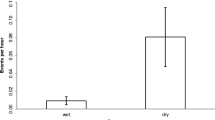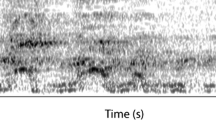Abstract
I examined sex differences in the ranging patterns of 3 female and 3 male wild spider monkeys. Each of the focal males used the home range widely, whereas each of the focal females used a distinct, restricted area of the home range. The males traveled longer distances than the females did. Although males were consistently in larger parties than females were, travel speed was affected by party composition rather than party size. All-male parties traveled faster than other party types did. Foraging manner also differed between sexes. Males spent more time feeding on fruits and less time on flowers and traveled longer distances between feeding trees. Both males and females used salados, where they ate soil and drank water. Salado location is likely to have affected the ranging pattern. Males used boundary areas more frequently than females did, often traveling along the boundary area in alliance with other males. Males also used areas that had been part of neighboring groups’ home ranges and were not used at all by females of the group. Greater travel distance of males is likely to be facilitated by consumption of a higher caloric diet. I compare the social structure of spider monkeys with that of chimpanzees, whose society is characterized by male-philopatry and female dispersion.
Similar content being viewed by others
References
Boesch, C. (1996). Social grouping of Taï chimpanzees. In McGrew. W. C., Marchant, L. F., and Nishida, T. (eds.), Great Ape Societies, Cambridge University Press, Cambridge, pp. 101–113.
Carpenter, C. R. (1935). Behavior of red spider monkeys in Panama. J. Mammal. 16: 171–180.
Chapman, C. A. (1990). Association patterns of spider monkeys: The influence of ecology and sex on social organization. Behav. Ecol. Sociobiol. 26: 409–414.
Chapman, C. A., and Wrangham, R. W. (1993). Range use of the forest chimpanzees of Kibale: Implications for the understanding of chimpanzee social organization. Am. J. Primatol. 31: 263–273.
Doran, D. (1997). Influence of seasonality on activity patterns, feeding behavior, ranging and grouping patterns in Taï chimpanzees. Int. J. Primatol. 18: 183–206.
Eisenberg, J. F. (1976). Communication Mechanisms and Social Integration in the Black Spider Monkey, Ateles fusciceps robustus, and Related Species. Smithonian contribution to zoology, 213.
Goodall, J., Bandora, A., Bergmann, E., Busse, C., Matama, H., Mpongo, E., Pierce, E., and Riss, D. (1979). Intercommunity interactions in the chimpanzee population of Gombe National Park. In Hamburg, D. A., and McCown, E. R. (eds.), The Great Apes. Menlo Park: Benjamin/Cummings, pp. 13–53.
Hasegawa, T. (1990). Sex differences in ranging patterns. In Nishida, T. (ed.), The Chimpanzees of the Mahale Mountain, University of Tokyo Press, Tokyo, pp. 99–114.
Hladik, C. M. (1977). Chimpanzees of Gabon and chimpanzees of Gombe: In Clutton-Brock, T. H. (ed.). Some Comparative Data on the Diet, Primate Ecology, Academic Press, London, pp. 483–501.
Inaba, A. (2000). Kumozaru no gun-kan kankei. (Intergroup relationships of wild spider monkeys in Macarena, Colombia.). In 16th Annual Meeting of Primate Society of Japan, Nagoya: Dogura & Co., Ltd., p. 257.
Izawa. K. (1993). Soil-eating by Alouatta and Ateles. Int. J. Primatol. 14: 229–242.
Izawa, K. (2000). Kumozaru mure no koudouiki no tokusei. (Characteristics of the home range of spider monkey groups) In Izawa, K. (ed.), Adaptive Significance of Fission-Fusion Society in Ateles, Miyagi University of Education, Sendai, pp. 21–36 (in Japanese).
Izawa, K., Kimura, K., and Ohnishi, Y. (1990). Chemical Properties of Soils Eaten by Red Howler Monkeys (Alouatta seniculus) II. Field studies of new world monkeys La Macarena Colombia. pp. 27–37
Izawa, K., Kimura, K., and Nieto, A. S. (1979). Grouping of the wild spider monkey. Primates 20: 503–512.
Izawa, K., and Mizuno, A. (1977). Palm-fruit cracking behavior of wild black-capped capuchin (Cebus apella). Primates 18: 773–792.
Izawa, K., and Mizuno, A. (1990). Chemical properties of special water drunk by wild spider monkeys (Ateles belzebuth) in La Macarena, (Colombia). Field Stud. New World Monkeys La Macarena Colombia 4: 38–46.
Kano, T. (1982). The social group of pygmy chimpanzees (Pan paniscus) of Wamba. Primates 23: 171–188.
Kimura, K., Nishimura, A., Izawa, K., and Mejia, C. A. (1994). Annual changes of rainfall and temperature in the tropical seasonal forest at La Macarena field station, Colombia. Field Studies New World Monkeys La Macarena Colombia 9: 1–3.
Klein, L. L. (1972). The Ecology and Social Organization of the Spider Monkey, Ateles belzebuth. Ph.D Diss. University of California, Berkley.
Mahaney, W. C. (1993). Scanning electron microscopy of earth mined and eaten by mountain gorillas in the Virunga Mountains, Rwanda. Primates 34: 311–319.
Milton, K. (1981). Food choice and digestive strategies of two sympatric primate species. Am. Nat. 117: 496–505.
Nishida, T. (1968). The social group of wild chimpanzees in the Mahale mountains. Primates 9: 167–224.
Nunes, A. (1995). Foraging and ranging patterns in white-bellied spider monkeys. Folia Primatol. 65(2): 85–99.
Portman, O. W. (1970). Nutritional requirements (NRC) of nonhuman primates. In Harris, R. S. (ed.), Feeding and Nutrition of Nonhuman Primates, Academic Press, New York, pp. 87–115.
Rodman, P. S., and Mitani, J. C. (1987). Orangutans: sexual dimorphism in a solitary species. In Smuts, B. B., Cheney, D. L., Seyfarth, R. M., Wrangham, R. W., and Struhsaker, T. T. (eds.), Primate Societies, Chicago University Press, Chicago and London, pp. 146–154.
Shimooka, Y. (2000). Ecological and sociological studies in wild spider monkeys MB-2 group at La Macarena, Colombia, In Izawa, K. (ed.), Adaptive Significance of Fission-Fusion society in Ateles, Miyagi University of Education, Sendai, pp. 37–56. (in Japanese.)
Shimooka, Y. (2003). Seasonal variation in association patterns of wild spider monkeys (Ateles belzebuth belzebuth) at La Macarena, Colombia. Primates 44: 83–90.
Stevenson, P. R. (2002). Frugivory and seed dispersal by wooly monkeys at Tinigua National Park, Colombia. Ph. D. thesis, State University of New York, Stony Brook.
Smith, R. J., and Jungers, W. I. (1997). Body mass in comparative primatology. J. Hum. Evol. 36: 523–559.
Strier, K. B. (1986). The behavior and ecology of the wooly spider monkey, or muriqui (Brachiteles arachnoides e. Geoffroyi 1806), Doctoral Dissertation, Harvard University, Cambridge.
Symington, M. M. (1987). Ecological and social correlates of party size in the black spider monkeys, Ateles paniscus chamek PhD thesis, Princeton, New Jersey.
Symington, M. M. (1988a). Demography, ranging patterns, and activity budgets of black spider monkeys (Ateles paniscus chamek) in the Manu National Park, Peru. Am. J. Primatol. 15: 45–67.
Symington, M. M. (1988b). Food competition and foraging party size in the black spider monkey (Ateles paniscus chamek). Behaviour 105: 117–134.
van Schaik, C. P., and van Hoof, J. A. R. (1996). Towards an understanding of the orangutan’s social system. In McGrew, W. C., Marchant, L. F., and Nishida, T. (eds.), Great Ape Societies. Cambridge Univ. Press, Cambridge, pp. 3–15.
Wakibara, J. V., Huffman, M. A., Wink, M., Reich, S., Aufreiter, S., Hancock, R. G. V., Sodhi, R., Mahaney, W. C., and Russel, S. (2001). The adaptive significance of geophagy for Japanese Macaques (Macaca fuscata) at Arashiyama, Japan. Int. J. Primatol. 22: 295–520.
Watts, D. P., and Mitani, J. C. (2001). Boundary patrols and intergroup encounters in wild chimpanzees. Behaviour 138: 299–327.
White, F. J. (1992). Pygmy chimpanzee social organization: variation with party size and between study sites. Am. J. Primatol. 26: 203–214.
Williams, J. M. Pusey, A. E., Carlis, J. V., Farms, B. P., and Goodall, J. (2002). Female competition and male territorial behaviour influence female chimpanzees’ ranging patterns. Anim. Behav. 63: 347–360.
Wrangham, R. W. (1979). Sex differences in chimpanzee dispersion. In Hamburg, D. A., and McCown, E. R. (eds.), The Great Apes. Menlo Park: Benjamin/Cummings, pp. 481–489.
Wrangham, R. W. (2000). Why are male chimpanzees more gregarious than mothers? A scramble competition hypothesis. In Kappeler, P. M. (ed.), Primate Males, Causes and Consequences of Variation in Group composition, Cambridge University Press, pp. 248–258.
Wrangham, R. W., Chapman, C. A., Clark-Arcadi, A. P., and Isabirye-Basuta, G. (1996). Social ecology of Kanyawara chimpanzees: implications for understanding the cost of great ape groups. In McGrew, W. C., Marchant, L. F., and Nishida, T. (eds.), Great Ape Societies. Cambridge University Press, Cambridge, pp. 45–57.
Author information
Authors and Affiliations
Corresponding author
Rights and permissions
About this article
Cite this article
Shimooka, Y. Sexual Differences in Ranging of Ateles belzebuth belzebuth at La Macarena, Colombia. Int J Primatol 26, 385–406 (2005). https://doi.org/10.1007/s10764-005-2930-0
Received:
Revised:
Accepted:
Issue Date:
DOI: https://doi.org/10.1007/s10764-005-2930-0




